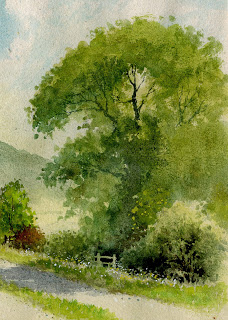I hope during this lengthy lockdown you are able to get out for exercise, fresh air and perhaps a little sketching, as these things are so vital to our well-being. Although it’s quite cold today, these winters are pretty mild compared to what it was like when I was a youngster, so there are many occasions when it is fairly comfortable to work outside. I live at the foot of vast moorlands, so I get up there as often as I can. In mid-January I sat on a rock painting distant snow-covered mountains in warm sunshine, in more comfort than many a summer day.
Today I have a winter scene on the Sussex Downs, which I did many years ago. A light coating of snow gives you the opportunity to bring in some colour while retaining the white of the paper where you wish to indicate pure snow. Keeping the landscape light in this way gives you the opportunity to make the most of cast shadows which will stand out strongly. I have cut a little off the left-hand side so that the details are not too small, although this does make it look as though I’ve plonked the farmhouse in the centre. Note the intermittent lines of ploughed furrows, which keeps it from being an overwhelming foreground. The massed trees in the distance have been enhanced by touches of highlights in places and the closest edge stands out where I have described one or two individual trees. The painting was done on Saunders Waterford NOT 140lb paper.
I shall be doing a couple of online watercolour workshops with Shopkeeparty in February, the first being on Thursday 11th at 2pm. This lasts for 45 minutes, is free, and you can join me in painting a simple landscape. All the details, including art materials are shown on the Shopkeeparty site and the free link is https://us02web.zoom.us/webinar/register/7916124614355/WN_kKSNDBCgQ9CyycEOLCCRgQ
The second workshop is on Thursday 25th February at 3..30pm and lasts 2 to 3 hours, for which there is a fee. Again, all the details are on the Shopkeeparty site. I hope to see you there. In the meantime, enjoy your painting.





